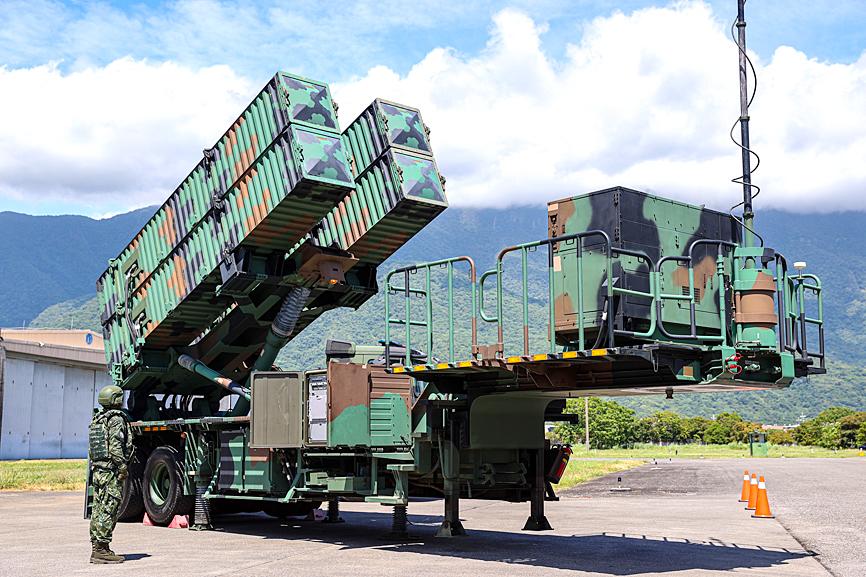The Hsiung Feng III missile project’s former chief engineer, Chang Cheng (張誠), has said that the military needs to extend the altitude of the Tien Kung III air-defense missile to effectively counter any threats from China.
In response to the rising military threat from China, the Ministry of National Defense has taken steps to increase missile production, raising production of the Tien Kung III missile from 48 units to 96 units per year, a defense official speaking on condition of anonymity said yesterday.
China’s live-fire missile drills earlier this month showed that the Tien Kung III air-defense missile cannot reach the altitude necessary to intercept some Chinese strikes, Chang wrote on Facebook on Tuesday.

Photo: CNA
The Chinese People’s Liberation Army (PLA) fired four Dongfeng-17 ballistic missiles into strategically key waters off eastern Taiwan where Taiwanese warships shelter and US forces would travel to counter a Chinese invasion, Chang said.
The missiles likely flew over Taiwan proper at an altitude of about 100km, the height they should reach when traveling the last one-third of their effective range, while the extended-range Tien Kung III has a service ceiling of 70km, he said.
This means the country’s premier air defense missile is incapable of shooting down Chinese ballistic missiles, he said.
“To intercept the PLA’s guided missiles at altitudes of 100km or more, the Chungshan Institute [of Science and Technology] would have to create a system capable of reaching 150km, similar to the US’ Terminal High Altitude Area Defense system,” Chang said.
The navy and the institute should join forces to design surface warships with an advanced air defense capability, mirroring that of the US Navy’s Advanced Electronic Guidance and Instrumentation System (AEGIS), he said.
AEGIS-equipped ships can defend a fleet from ballistic missiles by utilizing Standard Missile-2s and Standard Missile-6s, which are capable of defeating ballistic missiles, Chang said, adding that Hai Kung III missiles, which are close to being completed by the institute, could be used on such a warship.
A vertical launch system should also be built so that the theoretical warships could fire Hsiung Sheng missiles that have been designed for naval use, he said.
The anonymous defense official yesterday said that the extended-range Tien Kung III’s maximum interception height is probably 45km.
The missile launches seen on Thursday near the institute’s Jioupeng Military Base in Pingtung County’s Manjhou Township (滿州) were likely a test in which two extended-range missiles were fired at a simulated ballistic missile, the official said.
The military plans to establish 17 launch sites for the Tien Kung III missile before 2026 as part of Taiwan’s “porcupine” defense strategy, they said, adding that similar measures are being taken for anti-ship missiles.
The porcupine strategy refers to an asymmetric strategy that aims to make a territory difficult and costly to invade, which in part involves using anti-aircraft, anti-ship and anti-tank missiles against an opposing force’s large and expensive weapons platforms.

TRAGEDY STRIKES TAIPEI: The suspect died after falling off a building after he threw smoke grenades into Taipei Main Station and went on a killing spree in Zhongshan A 27-year-old suspect allegedly threw smoke grenades in Taipei Main Station and then proceeded to Zhongshan MRT Station in a random killing spree that resulted in the death of the suspect and two other civilians, and seven injured, including one in critical condition, as of press time last night. The suspect, identified as a man surnamed Chang Wen (張文), allegedly began the attack at Taipei Main Station, the Taipei Fire Department said, adding that it received a report at 5:24pm that smoke grenades had been thrown in the station. One man in his 50s was rushed to hospital after a cardiac arrest

SAFETY FIRST: Double the number of police were deployed at the Taipei Marathon, while other cities released plans to bolster public event safety Authorities across Taiwan have stepped up security measures ahead of Christmas and New Year events, following a knife and smoke bomb attack in Taipei on Friday that left four people dead and 11 injured. In a bid to prevent potential copycat incidents, police deployments have been expanded for large gatherings, transport hubs, and other crowded public spaces, according to official statements from police and city authorities. Taipei Mayor Chiang Wan-an (蔣萬安) said the city has “comprehensively raised security readiness” in crowded areas, increased police deployments with armed officers, and intensified patrols during weekends and nighttime hours. For large-scale events, security checkpoints and explosives

A car bomb killed a senior Russian general in southern Moscow yesterday morning, the latest high-profile army figure to be blown up in a blast that came just hours after Russian and Ukrainian delegates held separate talks in Miami on a plan to end the war. Kyiv has not commented on the incident, but Russian investigators said they were probing whether the blast was “linked” to “Ukrainian special forces.” The attack was similar to other assassinations of generals and pro-war figures that have either been claimed, or are widely believed to have been orchestrated, by Ukraine. Russian Lieutenant General Fanil Sarvarov, 56, head

PUBLIC SAFETY: The premier said that security would be tightened in transport hubs, while President Lai commended the public for their bravery The government is to deploy more police, including rapid response units, in crowded public areas to ensure a swift response to any threats, President William Lai (賴清德) said yesterday after a knife attack killed three people and injured 11 in Taipei the previous day. Lai made the remarks following a briefing by the National Police Agency on the progress of the investigation, saying that the attack underscored the importance of cooperation in public security between the central and local governments. The attack unfolded in the early evening on Friday around Taipei Main Station’s M7 exit and later near the Taipei MRT’s Zhongshan